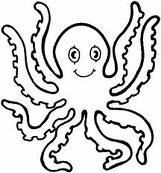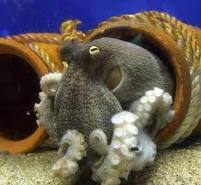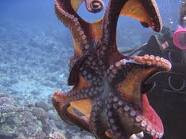Monday, February 28, 2011
DEFENSE
To protect themselves from being attacked by predators also human, usually the main octopus tends to hide from be detected as an octopus. Other than that, octopuses have several secondary defenses (only use when seen by the predator) which are:
· ink sacs
-The majority of octopuses can eject a thick blackish ink in a large cloud to escape form the predators. The ink is made up from melanin (which is used in hair product).
-The function of ink is to reduce the effectiveness of olfactory organs, that was use to smell for hunting, for example sharks.
http://www.youtube.com/watch?v=IeBPKnW4HmE
http://www.youtube.com/watch?v=IeBPKnW4HmE
· Color changing
-When under attack, octopuses will make use the Chromatophores to change their apparent color according to the environment.
-Chromatophores contain yellow, orange, red, brown and black pigments.
-The color changing was one of the methods for the octopuses to communicate and warn other octopuses
-Change the texture to seaweed, lizards, soil and so on.
EXOTIC FOOD
Humans eat octopus in many cultures. The arms and sometimes other body parts are prepared in various ways, often varying by species
In Japan, India, Hawaii and Tunisia, octopus was one of their daily foods because of its chewy texture.
- In Japan.
-Sushi, takoyaki, and Akashiyaki.
- Some small species are sometimes eaten alive as a novelty food.
- Octopuses hanging in the sunlight from a rope, just like laundry from a clothesline. They are often caught by spear fishing close to the shore.
- The fisherman brings his prey to land and tenderizes the flesh by pounding the carcass against a stone surface. Thus treated they are hung out to dry, and later will be served grilled either hot, or chilled in a salad.
· In India
-barbeceud octopus salad recipe
-octopus pasta
RELATIONSHIP OCTOPUS TO HUMAN
In Literature
· In literature field, octopuses were use as a symbolism because it was one of the ocean residences especially in Europe and Mediterranean. Some artifact found with octopuses image and story and artwork. For example, a stone carving found in the archaeological recovery from Bronze Age Minoan Crete at Knossos has a depiction of a fisherman carrying an octopus.
Vase from a Mycenaean Greek cemetery at Prosymna, Argos
Ancient Greek black-figure amphora, 530–520 BC, Staatliche Antikensammlungen, Munich, Germany
Moche Octopus (200 AD), Larco Museum Collection, Lima, Peru
(BOOK)
· The octopus has a significant role in Victor Hugo's book Travailleurs de la mer (Toilers of the Sea)
· Victor Hugo is French author and the novel was first published in Brussels in 1866.
- The book is dedicated to the island of Guernsey.
- In the story, the main character has, Gilliatt to battle with an octopus to get marry.
Image from the book
SIZE
- · Adults octopus usually weigh around 15 kg (33 lb), with an arm span of up to 4.3 m (14 ft)
- · The largest of all octopus species record is of a specimen weighing 272 kg (600 lb) and having an arm span of 9 m (30 ft).( E. dofleini)
image of adult octopus
small image of octopus
SENSATION
- · Octopuses have keen eyesight.
- · Can distinguish the polarization of light.
- · The octopuses sense the orientation of its body relative to horizontal.
- · An autonomic response keeps the octopus’s eyes oriented to keep the pupil always horizontal.
- · Octopuses have an excellent sense of touch where it can taste the touching.
- · The arms contain tension sensors.
- · Very poor proprioceptive sense.
- · Great difficulty learning about the detailed effects of its motions.
- · Limited hearing.
octopus move with head first
REPRODUCTION
When reproduction process occurs, the male’s octopuses will use their special arm (hectocotylus) to insert spermatophores (sperms) into the female’s reproductive system. The hectocotylus octopuses are usually in the third right arm.
· Males die after a few months of mating
- Some species of the female octopuses can keep the sperm alive for weeks until her eggs are mature.
- After fertilization, female lays about 200,000 eggs per time; it also depends on the family’s history, genera, species and individuals).
· The female hangs her eggs in strings from the ceiling of her lair.
· The female care for the eggs, protecting them from predators, and blowing currents of water to provide enough oxygen for the eggs.
· The female does not hunt during the one-month period and only spent time to care of the premature eggs.
· Female octopuses also sometimes ingest some of her arms for nourishments.
· Young larval octopuses spend a period of time drifting in clouds of plankton, where they feed larval crabs and larval starfish until they are ready to descend to the bottom of ocean.
Image of baby octopus
Sunday, February 27, 2011
INTELIGENCE
Except chimpanzee that was know because of it intelligent, octopus also highly intelligent. The issues of it intelligence and learning capability was one of the most debate among biologists. Based from experiments, it concludes that octopus have a memory system which can store:
a) Short – term system
The ability to store a small amount of information in mind actively for a short period of time.
b) Long – term system
A memory that can last as little as a few days or as long as decades
An octopus made up from highly complex nervous system where the brain was located. Neurons of octopus were in its arms. Octopus can be trained to differentiate between shapes and patterns. In an experiment, octopus reported to repeatedly releasing objects such as toys and bottles into their aquarium and then catching it back. They have been boarded fishing boats and opened holds to eat crabs. The octopus intelligence in using the tools can not be denied, four specimens of the Veined Octopus (type of octopus) have been witnesses retrieving discarded coconut shells, manipulate and them reassembling them to use as shelter.
Octopus open a bottle
INTRODUCTION TO E-LEARNING
The scope of this blog focusing on octopus:
1. biology research based on=
- intelligence
- reproduction
- sensation and size
2. relationship to human
- in literature ( as a symbolism)
- as a exotic food
- as pets
Subscribe to:
Comments (Atom)























